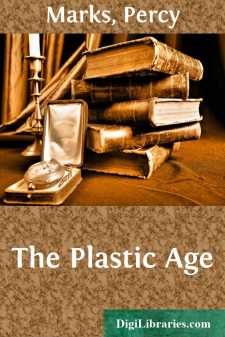Categories
- Antiques & Collectibles 13
- Architecture 36
- Art 48
- Bibles 22
- Biography & Autobiography 813
- Body, Mind & Spirit 142
- Business & Economics 28
- Children's Books 15
- Children's Fiction 12
- Computers 4
- Cooking 94
- Crafts & Hobbies 4
- Drama 346
- Education 46
- Family & Relationships 57
- Fiction 11828
- Games 19
- Gardening 17
- Health & Fitness 34
- History 1377
- House & Home 1
- Humor 147
- Juvenile Fiction 1873
- Juvenile Nonfiction 202
- Language Arts & Disciplines 88
- Law 16
- Literary Collections 686
- Literary Criticism 179
- Mathematics 13
- Medical 41
- Music 40
- Nature 179
- Non-Classifiable 1768
- Performing Arts 7
- Periodicals 1453
- Philosophy 64
- Photography 2
- Poetry 896
- Political Science 203
- Psychology 42
- Reference 154
- Religion 513
- Science 126
- Self-Help 84
- Social Science 81
- Sports & Recreation 34
- Study Aids 3
- Technology & Engineering 59
- Transportation 23
- Travel 463
- True Crime 29
The Plastic Age
by: Percy Marks
Categories:
Description:
Excerpt
CHAPTER I
When an American sets out to found a college, he hunts first for a hill. John Harvard was an Englishman and indifferent to high places. The result is that Harvard has become a university of vast proportions and no color. Yale flounders about among the New Haven shops, trying to rise above them. The Harkness Memorial tower is successful; otherwise the university smells of trade. If Yale had been built on a hill, it would probably be far less important and much more interesting.
Hezekiah Sanford was wise; he found first his hill and then founded his college, believing probably that any one ambitious enough to climb the hill was a man fit to wrestle with learning and, if need be, with Satan himself. Satan was ever before Hezekiah, and he fought him valiantly, exorcising him every morning in chapel and every evening at prayers. The first students of Sanford College learned Latin and Greek and to fear the devil. There are some who declare that their successors learn less.
Hezekiah built Sanford Hall, a fine Georgian building, performed the duties of trustees, president, dean, and faculty for thirty years, and then passed to his reward, leaving three thousand acres, his library of five hundred books, mostly sermons, Sanford Hall, and a charter that opened the gates of Sanford to all men so that they might "find the true light of God and the glory of Jesus in the halls of this most liberal college."
More than a century had passed since Hezekiah was laid to rest in Haydensville's cemetery. The college had grown miraculously and changed even more miraculously. Only the hill and its beautiful surroundings remained the same. Indian Lake, on the south of the campus, still sparkled in the sunlight; on the east the woods were as virgin as they had been a hundred and fifty years before. Haydensville, still only a village, surrounded the college on the west and north.
Hezekiah's successors had done strange things to his campus. There were dozens of buildings now surrounding Sanford Hall, and they revealed all the types of architecture popular since Hezekiah had thundered his last defiance at Satan. There were fine old colonial buildings, their windows outlined by English ivy; ponderous Romanesque buildings made of stone, grotesque and hideous; a pseudo-Gothic chapel with a tower of surpassing loveliness; and four laboratories of the purest factory design. But despite the conglomerate and sometimes absurd architecture—a Doric temple neighbored a Byzantine mosque—the campus was beautiful. Lawns, often terraced, stretched everywhere, and the great elms lent a dignity to Sanford College that no architect, however stupid, could quite efface.
This first day of the new college year was glorious in the golden haze of Indian summer. The lake was silver blue, the long reflections of the trees twisting and bending as a soft breeze ruffled the surface into tiny waves. The hills already brilliant with color—scarlet, burnt orange, mauve, and purple—flamed up to meet the clear blue sky; the elms softly rustled their drying leaves; the white houses of the village retreated coyly behind maples and firs and elms: everywhere there was peace, the peace that comes with strength that has been stronger than time....


